Museum Eye
Published in Issue 5 (Sep/Oct 2006), Reviews, Volume 14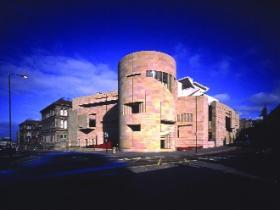
A large and impressive building that will remind the Irish visitor of the Millennium wing of our own National Gallery.
National Museum of Scotland
Chamber Street, Edinburgh
+44 (0)131 247 4422, info@nms.ac.uk
Mon.–Sat. 10am–5pm, Sun. 12pm–5pm
by Tony Canavan
The opening of the National Museum of Scotland coincided with the opening of the new Scottish parliament and was widely seen as part of Tony Blair’s devolution package for the United Kingdom. For many Scots the museum itself was an overdue official recognition of their country’s status as a historic nation. The new museum is an extension to the older Royal Museum of Scotland, which houses an eclectic collection of artefacts reflecting art, design and manufacturing but was never intended to tell ‘Scotland’s story’ as the new National Museum does.
It is a large and impressive building that will remind the Irish visitor of the Millennium wing of our own National Gallery. In seven levels it covers all aspects of Scotland’s history from the prehistoric period to the modern. Unlike our own National Museum, it self-consciously sets out to establish Scotland’s credentials as a nation and to trace its development.
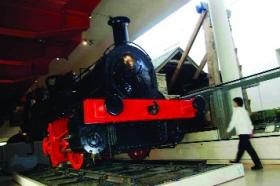
On level 3 you can see working steam engines and locomotives among other examples of this nation’s industrial heritage.
There is much to interest the Irish visitor seeking evidence of the long-established connection between our two nations, yet there is some disappointment, as the museum’s designers appear reluctant to acknowledge any debt to Ireland.
The lowest floor of the museum, level 0, is the most conventional. It is concerned with the prehistoric period and has cabinet after cabinet of objects with no accompanying hi-tech wizardry. You could spend all day exploring this vast collection, with its range of artefacts from the Stone Age to the Iron Age. Those peoples who were there before Scotland became a nation are represented, including the Romans and the Picts.
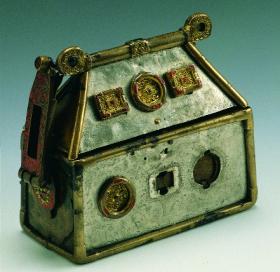
The Moneymusk reliquary.
Level 1 begins the story of the nation, and you enter it through a foyer decorated with quotations from the Declaration of Arbroath, perhaps Europe’s earliest declaration of independence, and a list of kings from the mythical to the historical. While ‘the kingdom of the Scots’ is emphasised, there is little to suggest that the term originally referred to the Irish. Nevertheless there is much to admire on this level, from the seventh-century harp to the Lewis chessmen, the latter reflecting the Viking heritage of Scotland. Interestingly, the titles on the information panels are in Gaelic and English, such as Adhaircean Phudair (Powder Horns) or Snaidheadh Chlacha (Carved Gravestones). There is a wealth of material here reflecting the peoples—the early Scots (‘the Gaels from Ireland’, as one panel says), the Picts, the Angles, the Vikings and the Normans—who became the Scottish nation. As well as the objects, there are information panels and touch-screen VDUs to add to the visitor experience. From an Irish perspective, there is a lot on the Gaelic language and culture. Interestingly, it is John Derricke’s sixteenth-century Image of Ireland that is used to illustrate Gaelic Scotland.
The other sections on Scottish history from the medieval to the early modern period will be familiar to most Irish visitors, who will know something of Robert the Bruce and Scotland’s struggles against the English. There is a plethora of material in the form of royal regalia, banners, artwork and so on to show that Scotland was a kingdom on a par with any in Europe in terms of cultural and political development. This political side of the story is carried on throughout the museum and reflects aspects of our own history as well: the seventeenth-century wars, the fate of James VII (II in Irish history), union with England and rebellion. As well as this a great amount of space is devoted to social history: the church, the development of towns, trade, industry and domestic architecture, for example. Objects worth highlighting are the 1520 Fetternear banner made of embroidered silk, the ornate silver Bute maser (drinking cup), a claymore believed to have belonged to Robert the Bruce and the cradle of the baby James VI. Continuing to look with an Irish eye, you will notice the prominent part played by Irish saints, such as Finan and Columba, in the early church, and Irish artefacts such as methers on display. A particularly bizarre object is the mask made of leather and human hair worn by Alexander Peden, a rebel covenanter during Scotland’s seventeenth-century religious conflicts.
The modern era begins on level 3, with eighteenth-century Scotland represented through silverware, clocks, furniture and so on. Aside from the politics, this section concentrates on the importance of science and industry in Scotland’s development. Indeed, you might say that these two things are as important in Scotland’s identity as culture and history.
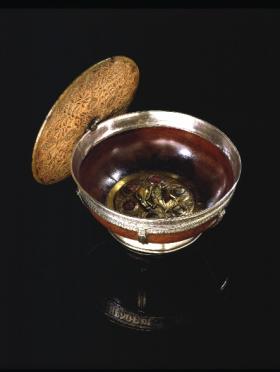
Bute maser and lid.
Scottish inventors are featured alongside the growth of Scottish industry, leading you on to the next
level, devoted to Industry and Empire. There you can see working steam engines and locomotives, among other examples of this nation’s industrial heritage. Here too are artefacts—weapons, costumes, art, etc.—from across the British Empire, brought back by Scots soldiers and administrators. Also on this level is a small section on Irish immigration. Here, among other things, are Orange and Hibernian sashes, pottery figures (note in particular ‘Wee MacGregor’ in a Celtic shirt), a book on 1798 and tools used by Irish migrant labourers. Unfortunately the other levels were inaccessible on the day that I visited.
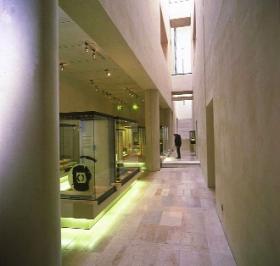
The ‘early peoples’ gallery is on level 0.
(All images National Museum of Scotland)
This is an excellent museum and has much to offer from an Irish perspective, not just in comparing the history of a fellow Celtic country but also in the direct Irish connections. It would be advisable to go on one of the free guided tours as it is a rambling maze of a building and it is easy to get lost or accidentally bypass a major gallery. The museum strikes a good balance between objects and technology as the interactive displays do not compete for attention with the artefacts, although in many places information panels are very wordy (a self-conscious attempt to explain things ‘properly’ perhaps?). Throughout the museum there are a lot of models of towns, ships, engines, etc., as well as mannequins wearing costumes, all adding to the spectacle. From an Irish perspective the museum has some notable absences, for example no mention of Scots and the Plantation of Ulster or of James Connolly, who played a key role in Scottish trade unionism before coming to Ireland. That said, this museum is worth a visit, and if you have the time and energy do go to the roof terrace for a stunning panorama of Edinburgh and beyond.
Tony Canavan is a former Museum Officer of Newry and Mourne District Council.
















